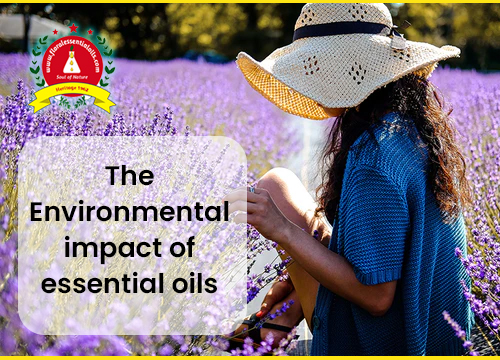Essential oils have become increasingly popular in recent years, thanks to their aromatic qualities and potential health benefits. From lavender and eucalyptus to peppermint and tea tree, essential oils are used in everything from aromatherapy to personal care products. While they may seem like a natural and eco-friendly alternative to synthetic chemicals, the growing demand for essential oils raises important questions about their environmental impact.
In this blog, we’ll explore how essential oils affect the environment, focusing on the processes involved in their production, the sustainability of the plant sources, and what we as consumers can do to minimize the environmental footprint of using essential oils.
The Extraction Process and Resource Intensity
Essential oils are extracted from various parts of plants, including flowers, leaves, bark, roots, and fruits. The most common methods of extraction are steam distillation and cold pressing. While these processes are essential for obtaining the oils, they require significant amounts of plant material and energy.
For example, producing just one pound of lavender essential oil requires around 220 pounds of lavender flowers, while a pound of rose essential oil may require up to 10,000 pounds of rose petals. This highlights the resource-intensive nature of essential oil production, which can lead to overharvesting and depletion of natural plant populations if not managed sustainably.
Steam distillation, one of the most common extraction methods, also consumes large amounts of water and energy. It requires heating the plant material to release the oils, which contributes to the carbon footprint of essential oil production. Cold-pressed methods, often used for citrus oils, are somewhat less energy-intensive but still require significant plant material.
Overharvesting & Threats to Biodiversity
The growing global demand for essential oils can lead to overharvesting of certain plant species, especially those that are rare or difficult to cultivate. Some plants used for essential oils, such as sandalwood and frankincense, are already facing sustainability challenges due to overexploitation. Sandalwood, for example, has become endangered in some parts of the world due to excessive harvesting for its valuable oil.
When plants are overharvested without being replenished, ecosystems can become disrupted, leading to a decline in biodiversity. Over time, this can affect not just the specific plant species but also the wildlife and other plant life that depend on these ecosystems. In areas where essential oils are source unsustainably, entire ecosystems can be at risk, contributing to deforestation, habitat loss, and soil degradation.
Agriculture and Pesticide Use
The cultivation of plants for essential oils often involves large-scale agriculture, which can have its own environmental downsides. To meet the rising demand, farmers may grow essential oil crops using industrial farming practices, often applying pesticides and fertilizers. These chemicals can contaminate soil, water, and air, affecting both local ecosystems and human health.
Monoculture farming—where a single crop is grown extensively over a large area—can also lead to soil depletion and a reduction in biodiversity. This farming method is common in the essential oil industry as it allows producers to maximize yields of specific plants. However, it comes at the cost of degrading the environment over time.
Transportation and Carbon Footprint
The essential oil industry operates globally, so producers often transport these products over long distances before they reach consumers. Countries around the world, including India, Madagascar, Bulgaria, and Australia, produce essential oils and ship them to markets in North America, Europe, and Asia. This long-distance transportation contributes to greenhouse gas emissions and increases the carbon footprint of essential oil products.
The packaging of essential oils also plays a role in their environmental impact. Essential oils are typically packs in small glass or plastic bottles, which may not always be recycle properly, contributing to waste.
Sustainable Practices in Essential Oil Production
Despite the environmental challenges posed by essential oil production, there are ways to mitigate these impacts. Some companies are adopting sustainable and ethical sourcing practices to minimize their environmental footprint. Sustainable essential oil production involves:
- Organic Farming: Using organic farming methods that avoid synthetic pesticides and fertilizers helps protect the environment and reduce pollution. Organic farms often use crop rotation, composting, and natural pest control to maintain soil health and biodiversity.
- Wild Harvesting with Care: In cases where essential oils are derive from wild plants. It is important to practice sustainable wild harvesting. This means collecting plant materials in a way that allows the plant populations to regenerate naturally, ensuring long-term availability without damaging the ecosystem.
- Fair Trade and Ethical Sourcing: Many essential oil companies are now working directly with local farmers and communities. So that it ensures fair wages, ethical working conditions, and sustainable farming practices. By supporting these initiatives, consumers can help reduce the environmental and social impacts of essential oil production.
- Certifications: Look for essential oils that have been certified by organizations. Such as the Rainforest Alliance, which ensure that products are source from sustainable and ethical way.
How Consumers Can Make a Difference
As consumers, we have the power to make more environmentally conscious choices when purchasing essential oils. Here are a few ways to minimize the environmental impact of essential oil use:
- Buy from Sustainable Brands: Look for companies that prioritize sustainability, ethical sourcing, and transparency in their production methods. Research the brand’s commitment to the environment before making a purchase.
- Use Essential Oils Sparingly: Essential oils are highly concentrated, meaning a little goes a long way. Using them sparingly not only extends the life of the product but also reduces the demand for excessive plant harvesting.
- Recycle Packaging: Ensure that the bottles and packs from essential oils are properly recycled to reduce waste.
Conclusion
While essential oils offer many benefits for health and wellness, it’s important to consider their environmental impact. The extraction, cultivation, and transportation of essential oils can have significant consequences for ecosystems, biodiversity, and the planet as a whole. By choosing sustainably sourced products and supporting ethical companies. We can enjoy the benefits of essential oils while minimizing their environmental footprint. Let’s make mindful choices to protect the environment while still enjoying the natural power of essential oils.
For high-quality, sustainably sourced oils, explore the selection from Floral Essential Oils. Our commitment to environmentally conscious practices ensures that you can enjoy the benefits of essential oils while supporting a greener future.




